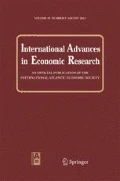Abstract
We examine the division of labor within households and marital matching patterns in the USA using both the Current Population Survey (CPS) and the National Longitudinal Survey of Youth (NLSY). We use Becker’s theory of marriage markets by estimating household production functions and using the estimates to test for positive or negative assortive matching. We also construct match matrices, which are used to judge how well our model fits Becker’s theory. We find positive assortative matching on all traits in young marriages and couples without children, and negative assortment along some traits in marriages with children. This suggests that children induce specialization whereas couples without children exploit household public goods.
Similar content being viewed by others
Notes
Efficiency results—that is, household output is maximized—if couples are matched along the main diagonals of the match matrices.
For example, Edlund (1999) claims, “In fact hypergamy is the socially more accepted, and presumably more common, form of mixed-class unions” (p.1277).
The goods produced can include quantity and quality of children, love and companionship, and so on.
Jepsen and Jepsen (2002) is an exception in that they examine matching using multivariate (logit) techniques.
These parameters are required for construction of the match matrices below.
We experimented with the number of types of males and females in the marriage market and found that introducing this variation did not alter the results of the paper.
Appendix A1 provides details of the logit procedure.
Results supporting positive and negative assortative mating under the alternative specifications are available upon request from the authors.
The Census Bureau provides information on the average age gap (men’s age – women’s age) for first and second marriages separately. For first marriages the average age gap is 2.3 years. The gap is less than one year for 36.2% of marriages. The wife is more than 5 years younger in 15.8% of marriages and more than 5 years older in 1.8% of marriages. For second marriages the numbers are 3.7 years (average gap), 21.3% (within 1 year), 34.7% (wife more than 5 years younger) and 5.2% (wife more than 5 years older). For our CPS sample, the corresponding numbers are 2.52 years (average gap), 31.8% (within 1 year), 19.7% (wife more than 5 years younger) and 3.18% (wife more than 5 years older).
Eighty observations were lost with this restriction. The models were also estimated with these 80 observations included. None of the conclusions in the paper were affected by this restriction.
Jepsen and Jepsen (2002) also separate their Census sample into childless couples and couples with children. Similar to the results (below) of this paper, their childless couples also exhibit positive assortative matching. However, in contrast to findings of this paper, they find “no significant evidence of positive or negative assortative matching” with respect to couples with children (p. 450).
For an alternative test, a sample of marriages in the CPS for which the groom’s age is less than 40 was used on the assumption that this sample is apt to have a large proportion of relatively young marriages and, therefore, be more similar to the NLSY79 sample than the unrestricted CPS sample. The results of this estimation, which are available on request, were similar to the results obtained from the sample of childless marriages in the CPS.
References
Becker, G. S. (1973). A theory of marriage: Part I. Journal of Political Economy, 81(4), 813–846.
Becker, G. S. (1974). A theory of marriage: Part II. Journal of Political Economy, 82(2), s11–s26.
Becker, G. S. (1985). Human capital, effort, and the sexual division of labor. Journal of Labor Economics, 3(1, Part 2), s33–s58.
Becker, G. S. (1991). A treatise on the family, enlarged edition. Cambridge, MA: Harvard University Press.
Edlund, L. (1999). Son preference, sex ratios, and marriage patterns. Journal of Political Economy, 107(6, Part 1), 1257–1304.
Epstein, E., & Guttman, R. (1984). Mate selection in man: Evidence, theory, and outcome. Social Biology, 31(3–4), 243–278.
Jepsen, L. K., & Jepsen, C. A. (2002). An empirical analysis of the matching patterns of same-sex and opposite-sex couples. Demography, 39(3), 435–453.
Kreider, R. M., & Fields, J. M. (2002). Number, timing, and duration of marriages and divorces: 1996. Current Population Reports, P70–80. Washington, DC: US Census Bureau.
Lam, D. (1988). Marriage markets and assortative mating with household public goods. Journal of Human Resources, 23(4), 462–487.
Mare, R. D. (1991). Five decades of educational assortative mating. American Sociological Review, 56(1), 15–32.
Nakosteen, R. A., & Zimmer, M. A. (2001). Spouse selection and earnings: Evidence of marital sorting. Economic Inquiry, 39(2), 201–213.
Pencavel, J. (1998). Assortative mating by schooling and the work behavior of wives and husbands. American Economic Review, 88(2), 326–329.
Suen, W., & Lui, H.-K. (1999). A direct test of the efficient marriage market hypothesis. Economic Inquiry, 37(1), 29–46.
Zhang, J., & Lui, P.-K. (2003). Testing Becker's prediction on assortative mating on spouses’ wages. The Journal of Human Resources, 38(1), 99–110.
Author information
Authors and Affiliations
Corresponding author
Rights and permissions
About this article
Cite this article
Dalmia, S., Sicilian, P. Kids Cause Specialization: Evidence for Becker’s Household Division of Labor Hypothesis. Int Adv Econ Res 14, 448–459 (2008). https://doi.org/10.1007/s11294-008-9171-x
Received:
Accepted:
Published:
Issue Date:
DOI: https://doi.org/10.1007/s11294-008-9171-x




